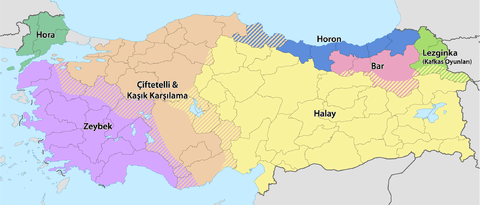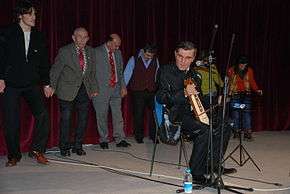Horon (dance)
Horon (Greek χορόν)[1] or khoron (Turkish: horon), refers to a group of a circle folk dances from the Black Sea region of Turkey.
History
The word horon comes from the Greek choros (χορός) which is the Greek word for "dance".[2] It is a traditional dance of the Black Sea region. It originated in Pontus, which is located in the north region of today's Turkey at the Black Sea coast.
Description
Many Pontian dances are almost identical in steps to Greek dances. Pontian dances also resemble Persian and Middle Eastern dances in that they are not led, with no single leader in the dance formation. This is different from Greek dances but is a widespread aspect of Persian and Middle Eastern dances. A unique aspect of Pontian dance is the tremoulo, which is a fast shaking of the upper torso by a turning of the back on its axis.
The rapid shoulder and upper body movements from the waist might have evolved only in modern times, during the Ottoman reign, as some people seem to believe. These movements are said to have derived from the shimmying of the little silver anchovy fish (Turkish hamsi) found in mass abundance in the Black Sea, which has worked its way into an inseparable part of northern Anatolian culture.
Horon types

- Omal (ομάλ), meaning “the calm, normal one”, in Turkish düz horon
- Tik (τικ), from “perpendicular”, in Turkish dik
- Argon (αργόν), meaning “the slow one”
- Tromakton (τρομαχτόν), meaning “the fierce one”, in Turkish titreme horonu
- So gonaton (σο γόνατον), meaning “on the knee”
- Langefton (λαγκευτόν), meaning “the jumped, hopped one”
- Karslidikon (καρσλίδικον), meaning “the one from Kars”
- Diplon (διπλόν), meaning “the double one”
- Dipat or Giavaston (διπάτ, γιαβαστόν), meaning “double step”, in Turkish ikiayak horon
- Ters (τερς), meaning “the wrong or incorrect one” from Turkish ters (the dance exists in two versions, one from the Akdağmadeni town and district in Yozgat, one from Kioumoush Maten)
- Tas (τας)
- Trigona (τρυγόνα), meaning “pigeon” or Turkish dirvana (which exists in different versions in Trapezounta, Matsouka, Kerasounta)
- Seranitsa (σερανίτσα) or Laz horon, referring to the Laz people (two versions from Trapezounta and Sheriana)
- Serra (σέρρα), named after the river Serra (Trabzon); in Turkish sıksara horon
- Masher or Maheria (Μαχαίρια) or Pyrecheios (πυρήχειος, Turkish bıçak oyunu), an ancient Greek dance described by the ancient historian Xenophon as picturing “the sound of fire” (in the film The Addams Family, Gomez Addams dances the Masher)
- Kots (κοτς), meaning “heel dance”
- Kotsari (κότσαρι), a Greek folk dance, meaning “heel dance”, Turkish koçari
- Almatsouk (αλματσούκ)
- Titara (τίταρα, existing in two version from Argyroupoli and Kars)
- Giurvalandun (γιουρβαλαντούν)
- Samson (σαμσόν), “from Samsun”
- Etere (έτερε)
- Karsilamas (καρσιλαμάς), from Kars, from Turkish karşılama “face to face”
- Pipilomatena (πιπιλομάτενα), meaning “with soft eyes”
- Tsurtuguzus (τσουρτούγουζους)
- Momogera (μομόγερα), meaning “immature old man”, Turkish momoyer
- Atsapat (ατσαπάτ), from Turkish Akçaabat
- Gemura (γέμουρα), meaning “from Yomra”, a town close to Trabzon
- Diplon Omal (διπλόν ομάλ), meaning “double calm”
- Kalon Korits (καλόν κορίτσ), meaning “good girl”
- Kymishanalidikon (κιμισχαναλίδικον), meaning from Gumushane
- Dolme (ντολμέ)
- Utsai (ούτσαϊ)
- Sarikuz (σαρικουζ), from Turkish sarı kız “blond girl”
- Siton (σιτόν)
- Tamsara (τάμσαρα), “from Tamzara town”, Giresun
- Tyrfon (τυρφόν)
- Fona (φόνα)
- Hala-Hala (χάλα-χάλα)
- Halai (χαλάϊ), a variant of the Halay dance
